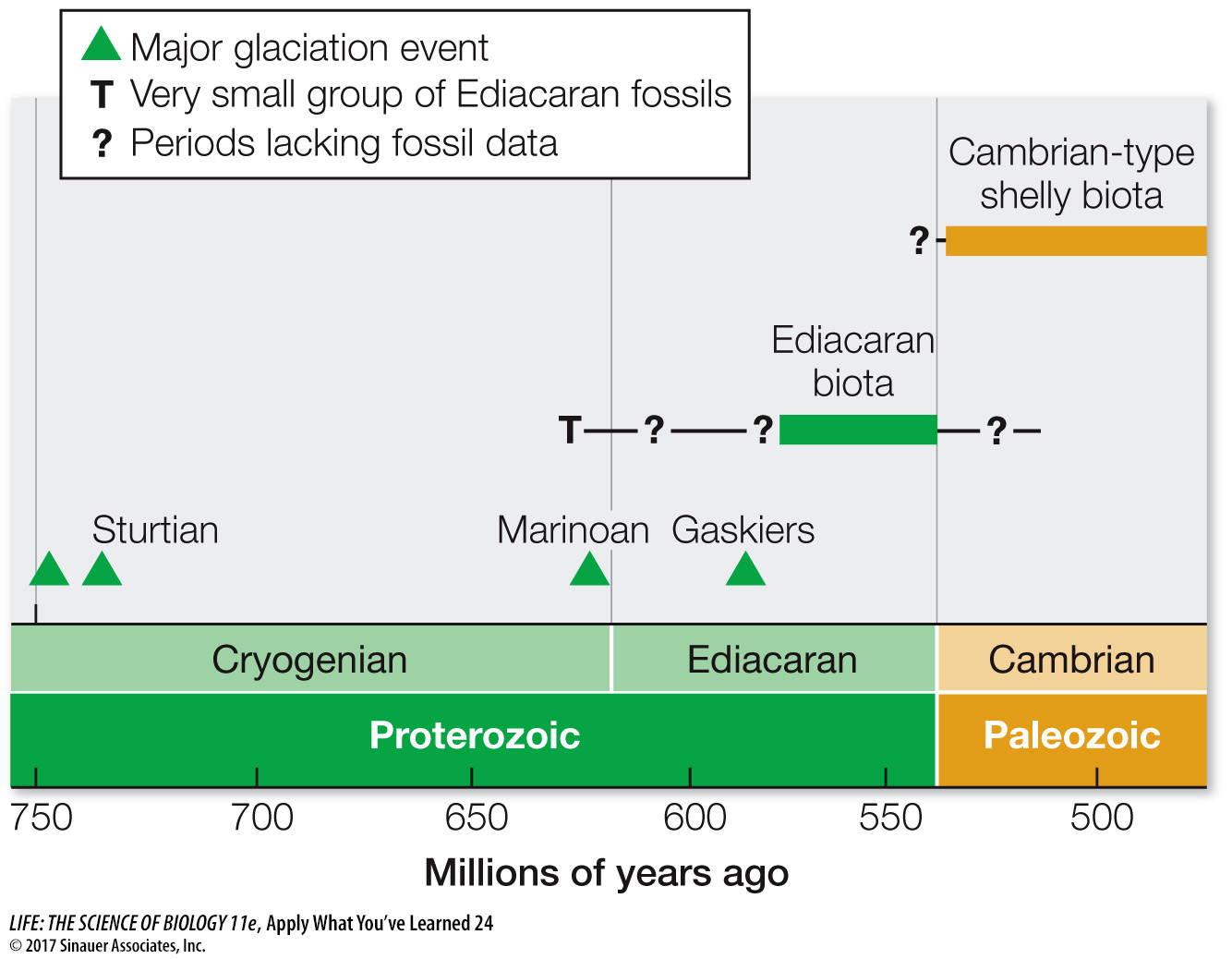Apply What You’ve Learned
Review
24.1
Geologists use several methods to date ancient events.
24.3
Earth’s history is divided into geological periods that are associated with major events in biological evolution.
The diagram below summarizes evidence gathered through the study of fossils and rocks from locations around the world. Assemblages of two groups of animal fossils are indicated as the Ediacaran biota and the Cambrian-

The Ediacaran biota represents the remains of the oldest large multicellular animals in Earth’s history. These were soft-
Ediacaran animals appear to have flourished for at least 23 million years (as indicated in the diagram) before going extinct. They were followed by the Cambrian-
Questions
1.
How would the geological strata in which Ediacaran fossils were discovered compare with those in which Cambrian-
The Ediacaran fossils would have been discovered in older sedimentary strata lying below younger strata where Cambrian-
2.
What factors were likely to have favored the success of the Ediacaran biota at that time in Earth’s history, but not earlier?
The Ediacaran fauna evolved only after levels of atmospheric oxygen were high enough to support multicellular life forms. Therefore one factor that favored the success of the Ediacaran was the increase in atmospheric oxygen that occurred at this time. Another factor was the ending of glaciation events, which occurred as Earth warmed. The resulting loss of ice cover allowed sunlight to penetrate seawater more effectively, which spurred increased rates of photosynthesis. This further increased oxygen concentrations in aquatic environments. Warmer temperatures in general increased reaction rates, including those in life forms to speed their growth and reproduction; this also favored success of the Ediacaran fauna at that time in Earth’s history.
3.
What factors could have resulted in the extinction of the Ediacaran biota and the rise of the Cambrian-
The physical environment remained favorable for the evolution of multicellular organisms, since the Cambrian-
4.
It has been stated that “absence of evidence is not evidence of absence” in reference to the interpretation of the fossil record. Evaluate this statement as it relates to the study of the Ediacaran biota.
The statement suggests that the lack of fossil discovery does not mean that organisms producing those fossils did not exist. The lack of discovery of fossils may just mean that fossils exist but have not yet been found, or that the organisms died without leaving fossils, or that fossils were formed but have degraded over time. We have to keep open the possibility that the Ediacaran biota lived before or beyond the time period for which we have fossil evidence at present. However, until such evidence is found, the available evidence supports the hypothesis that the Ediacaran fauna arose and went extinct in the time period shown in the diagram.
5.
An index fossil is one whose presence in a geological formation can indicate the age of the formation. Propose a scenario to illustrate how Ediacaran fossils might be used as index fossils. Explain your reasoning.
Suppose a geological formation is dug up and surveyed for the presence of fossils. If Ediacaran fossils are found in the same strata as fossils of organism X, one could conclude that organism X existed in the same time period as the Ediacaran biota. This would date the existence of organism X to the same time period as the Ediacaran biota. This would be possible because fossils located in the same strata were deposited in sediment at the same time. The dating of the strata would be possible because the Ediacaran biota existed in a fairly narrow time window. This would all change, however, if new evidence placed Ediacaran biota at an earlier or later time than what scientists have observed so far.